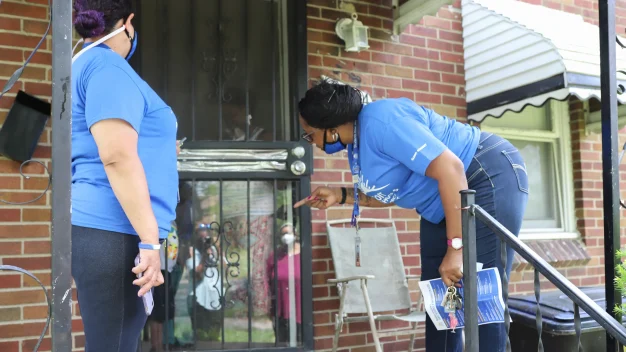
Why are U.S students missing so much school? The answer may lie in the chronic absenteeism ‘black box’
Alarms are going off nationwide about absenteeism. Many more students than usual missed big chunks of school during the pandemic, with some school districts seeing their chronic absenteeism rates double.
That metric, which looks at the share of students who missed 10% or more of the school year, is an important one. But it doesn’t offer any insight into why a student missed so much class — especially important in a period when students were often told to quarantine — or how best to help them.
Research released this month suggests that if schools want to answer those questions, they’ll have to open the “black box” of that chronically absent label.
“Because it’s super simplified, it’s hiding a lot of nuances,” said Jing Liu, an assistant professor at the University of Maryland’s College of Education. “We need to differentiate the reason behind absences to know how to help an individual kid.”
That’s what Liu and a colleague set out to do when they examined daily, class-level attendance data for nearly 40,000 middle and high school students in a big-city California district from the 2015-16 to 2017-18 school years.
A few patterns jumped out: Unexcused absences spiked as the year progressed, while excused absences held steady. Black and Hispanic students and students from low-income neighborhoods racked up unexcused absences faster than their white and more affluent peers. And when students missed a lot of class at the start of the year, their absences stacked up at a faster rate, too.
With that level of detail, Liu said, “you can intervene in a much more timely manner.”
Together, the findings underscore the power of detailed attendance data as schools try to re-engage students and curtail absenteeism. And though more districts are beefing up their tracking efforts with the help of COVID relief funds, many lack the details that would tell them what last year’s absences truly mean or offer clues about how to prevent students from missing class in the future.
“In most cases,” Liu said, “a sufficient system is not in place.”
Over the last decade, schools have begun paying closer attention to absenteeism, as the federal education department required schools to report this data and several states tied the metric to school ratings. The stakes are high: chronic absenteeism has been linked to higher dropout rates, lower academic achievement in reading and math, and school disengagement.
‘The stakes are high’
Nationally, about one in five students was chronically absent during the first full pandemic school year — an increase of two million students, according to newly released federal data analyzed by researchers at the nonprofit Attendance Works and Johns Hopkins University.
National data isn’t yet available for last school year, but several places have reported eye-popping increases. In New York City, 41 per cent of students were chronically absent last year, up from around 27 per cent the year before the pandemic began. In the Las Vegas area, the rate skyrocketed to 40 per cent from 22 per cent over that time. In Connecticut, 24 per cent of students were chronically absent last year, up from 10% before COVID hit. And in Ohio, the rate soared to 30 from 17 per cent.
As a result, districts are hiring more attendance staff, visiting students at home, or offering students gift cards for improved attendance. San Antonio’s district foundation is even hosting a car giveaway.
But figuring out exactly why chronic absenteeism is up can be tricky, especially since required quarantines, and COVID itself, kept lots of students out of school for stretches of time. Some districts tried to gather more details about these types of absences, but there wasn’t much consistency.
“There just got to be a lot of confusion,” said Hedy Chang, the executive director of Attendance Works.
A few districts, like Los Angeles Unified, gathered enough details to pinpoint COVID’s effect. There, about half of all students were chronically absent last year, up from 19% before the pandemic. Quarantines accounted for 20 percentage points of that increase, district officials said, but another 11 points were due to other factors.
Others tried to untangle the various causes, but data issues ultimately left them in the dark.
In Fargo, North Dakota, for example, when attendance specialists followed up with parents who frequently reported their child was home with COVID or in quarantine, they sometimes found out the real reason was that the child had anxiety about coming to school, was being bullied, or felt they had fallen behind in a certain class.
“A lot of times though, parents are very keen to kind of hide what’s going on in their lives from you,” said Gabe Whitney, a district attendance specialist. “That’s the difficulty of our roles, is trying to figure out exactly why the students are gone.”
‘The difficulty is trying to figure out why the students are gone’
New Mexico’s Santa Fe schools created a special ‘Q’ code – which didn’t count as an absence – to indicate when a student tested positive for COVID or had been sent home with COVID symptoms. But officials think the code was underused and some students who should have been marked as ‘Q’ racked up absences.
What schools are most worried about is students missing school because they are uninterested or unwilling to attend. But the line between the disengagement and COVID issues isn’t always clear either, Chang noted.
“Let’s imagine a child, they’re quarantined for 10 days,” she said. “They were in chemistry, and now they don’t come back because they feel so far behind. Was that due to quarantine, or not?”
Some districts are moving toward collecting the kind of data that notes why students are absent and who most needs extra outreach.
Santa Fe schools purchased a new attendance-tracking system that makes it easier to spot racial or other disparities.
Schools in North Carolina’s Charlotte-Mecklenburg County are launching a new system this month that will flag students trending toward chronic absenteeism – but if a student is simply out sick, that label will drop off once they’ve returned to school for a bit.
And Fargo is using a new system that sorts students into different tiers based on attendance data that updates daily. “We’re able to click a button and get real-time data,” said Tamara Uselman, Fargo’s director of equity and inclusion. “We also know for whom the system is working well, and for whom we need to make some changes.”
With that detailed data in hand, school officials say they’re more quickly able to get support to students missing the most class time. In Santa Fe, after a student is gone a few days, a teacher calls home to check in. But when absences start piling up, school attendance teams and an expanded team of attendance coaches step in with strategies like family meetings and home visits.
‘What is happening that has prevented you from going to school’?
“We are going to the home and saying: ‘Hey, we haven’t seen you in a while and we’re really worried about you and want you back in school,’” said Crystal Ybarra, the district’s chief equity, diversity, and engagement officer, who is overseeing the attendance initiative. Staff are also trying to figure out: “What is happening that has prevented you from going, and let’s see if we can get some ideas for how to fix this.”
Other findings in the research conducted by Liu and Monica Lee, of Brown University, suggest that efforts to improve school climate and culture could be a promising way to combat absenteeism.
By combining attendance and student survey data, Liu and Lee found that students who accumulated unexcused absences more quickly were also more likely to feel like they didn’t belong at school and were getting less academic help than their peers.
Chang has noticed more districts paying attention to those dynamics and helping students build nurturing relationships with adults as part of their attendance initiatives.
In Fargo, where the chronic absenteeism rate shot up to 30% last year — nearly three times higher than pre-pandemic — staff noticed even higher rates of absenteeism for Native American and Black students. To Uselman, that disparity signaled the need to improve school culture.
So with the help of COVID funds, the district hired a cultural specialist who works with teachers to make sure Native history is taught accurately and that Native perspectives are regularly included in lessons. And the district added a writers workshop run by two Black instructors that’s been popular with Black students.
The district’s two attendance specialists are also meeting with students who’ve missed a lot of class time to ask how their school could help.
“A lot of kids that are absent in school, they may be behind in the class, really feel like they don’t have a place in the class, or the teacher doesn’t understand them or respect them as the person they are. And that creates issues where they don’t want to be in those classes,” said Nick Hawkins, one of Fargo’s specialists. “It all begins with respect and feeling welcomed and feeling understood.”
This story was originally published by Chalkbeat. Sign up for their newsletters at ckbe.at/newsletters.
Kalyn Belsha is a national education reporter based in Chicago. Contact her at kbelsha@chalkbeat.org.
Additional reporting by Sarah Darville
Chalkbeat is a nonprofit news site covering educational change in public schools in the U.S




